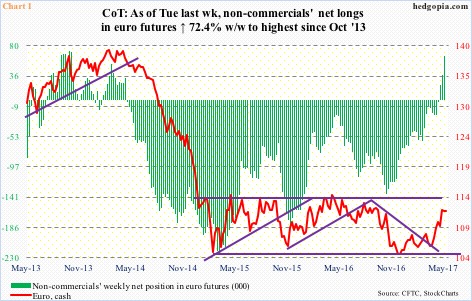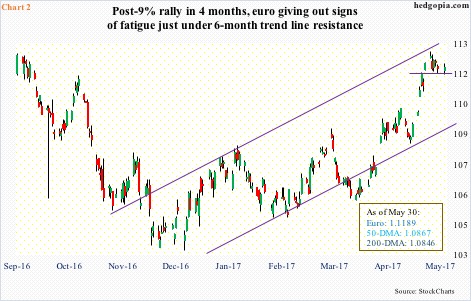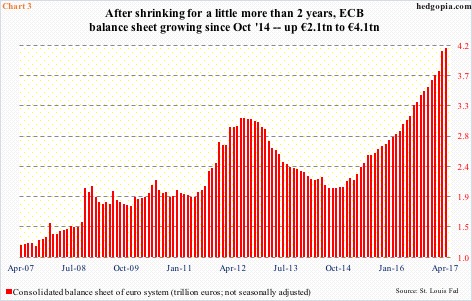The euro looks tired. A pause in a prevailing uptrend or a decent peak? Non-commercial futures traders can potentially decide.
Non-commercials have never been as bullish in euro futures since October 2013. As of Tuesday last week, they held nearly 65,000 net longs, having switched from net short to net long three weeks ago (Chart 1).
These traders tend to be trend followers.
The trend in the cash is – or, had been – up. From low to high intraday between January 3 and May 22 this year, the currency rallied from $1.0341 to 1.1265 – up 8.9 percent (Chart 2). In the currency land, this is big.
Going back further, the euro has essentially been range bound for over two years. It suffered a harrowing drop from 1.3993 in May 2014 to 1.0462 in March 2015. That low was slightly undercut this January, otherwise essentially marked the bottom of the range. The top lies at 1.14-1.15.
Evidently, the currency is giving out signs of fatigue before reaching the top of the range. Non-commercials in this regard can play a role in deciding whether this becomes a short- or medium-term peak.
As noted above, holdings in Chart 1 are as of Tuesday last week. Data as of this Tuesday will be released this Friday. And they can provide some clues. (Back in late 2013/early 2014, non-commercials began to reduce net longs from comparable levels.)
Looking at the monthly chart, there is still room for the euro to rally. A trend line drawn from the April 2008 high of 1.602 draws to 1.275 (not shown here). There is also horizontal resistance going back 13 years around 1.2. Then there is the afore-mentioned two-plus-year resistance at 1.14-1.15.
Particularly this year, the Eurozone economy is putting up good numbers – at least versus the U.S. This gave euro bulls a good excuse to rally the currency nearly nine percent in four months. But Mario Draghi, ECB president, is not yet ready to dial down the bank’s QE.
Tuesday, he said the Eurozone still needs an “extraordinary amount of monetary support.” The bank still buys €60 billion in bonds every month (beginning April), down from €80 billion. This is massive stimulus.
As of April, the ECB boasted a €4.1-trillion balance sheet, up from €2 trillion in September 2014 (Chart 3). In fact, size-wise, the ECB just surpassed the Fed. The latter has a $4.5-trillion balance sheet.
So at some point, the ECB will at least stop adding to its balance sheet – similar to what the Fed did back in October 2014. The latter is now discussing ways to begin to shrink its.
But, right here and now, Draghi has made it clear now is not the time to do so. The current QE runs through December anyway. This on the one hand can discourage potential euro bulls from initiating new positions on the other can tempt existing ones to lock in gains.
Risk/reward odds favor the euro heads lower. If nothing else, just to unwind daily overbought conditions. As well, the currency just kissed the upper end of a rising six-month trend line (Chart 2), and is overbought on a weekly chart as well.
Non-commercials would probably play a role if it proceeded to unwind the weekly conditions.
Thanks for reading!

